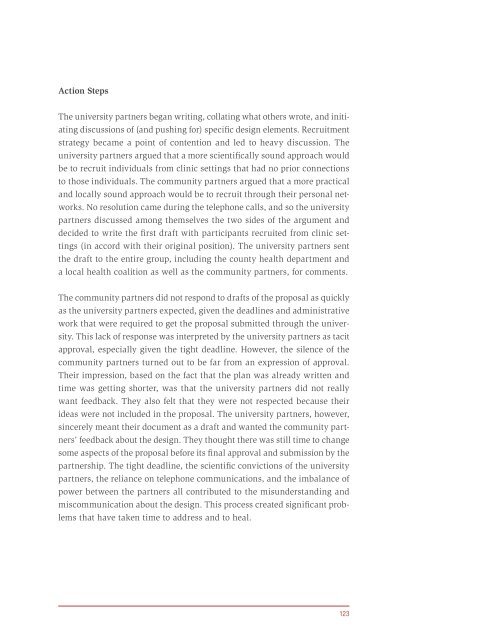Principles of Community Engagement (Second Edition)
Principles of Community Engagement (Second Edition)
Principles of Community Engagement (Second Edition)
You also want an ePaper? Increase the reach of your titles
YUMPU automatically turns print PDFs into web optimized ePapers that Google loves.
Action Steps<br />
The university partners began writing, collating what others wrote, and initi-<br />
ating discussions <strong>of</strong> (and pushing for) specific design elements Recruitment<br />
strategy became a point <strong>of</strong> contention and led to heavy discussion The<br />
university partners argued that a more scientifically sound approach would<br />
be to recruit individuals from clinic settings that had no prior connections<br />
to those individuals The community partners argued that a more practical<br />
and locally sound approach would be to recruit through their personal networks<br />
No resolution came during the telephone calls, and so the university<br />
partners discussed among themselves the two sides <strong>of</strong> the argument and<br />
decided to write the first draft with participants recruited from clinic settings<br />
(in accord with their original position) The university partners sent<br />
the draft to the entire group, including the county health department and<br />
a local health coalition as well as the community partners, for comments<br />
The community partners did not respond to drafts <strong>of</strong> the proposal as quickly<br />
as the university partners expected, given the deadlines and administrative<br />
work that were required to get the proposal submitted through the university<br />
This lack <strong>of</strong> response was interpreted by the university partners as tacit<br />
approval, especially given the tight deadline However, the silence <strong>of</strong> the<br />
community partners turned out to be far from an expression <strong>of</strong> approval<br />
Their impression, based on the fact that the plan was already written and<br />
time was getting shorter, was that the university partners did not really<br />
want feedback They also felt that they were not respected because their<br />
ideas were not included in the proposal The university partners, however,<br />
sincerely meant their document as a draft and wanted the community partners’<br />
feedback about the design They thought there was still time to change<br />
some aspects <strong>of</strong> the proposal before its final approval and submission by the<br />
partnership The tight deadline, the scientific convictions <strong>of</strong> the university<br />
partners, the reliance on telephone communications, and the imbalance <strong>of</strong><br />
power between the partners all contributed to the misunderstanding and<br />
miscommunication about the design This process created significant problems<br />
that have taken time to address and to heal<br />
123

















